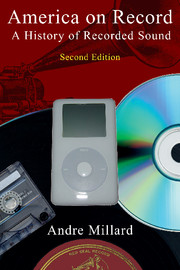Book contents
- Frontmatter
- Dedication
- Contents
- Preface to the second edition
- Preface to the first edition
- Introduction
- Part One The acoustic era
- 1 The inventors
- 2 A phonograph in every home
- 3 The international industry of recorded sound
- 4 The music
- 5 Recorded sound in the Jazz Age
- Part Two The electrical era
- Part Three The digital era
- Abbreviations used in the notes
- Notes
- Select discography
- Select bibliography
- Subject index
- Recordings index
- Motion picture index
4 - The music
from Part One - The acoustic era
Published online by Cambridge University Press: 05 February 2015
- Frontmatter
- Dedication
- Contents
- Preface to the second edition
- Preface to the first edition
- Introduction
- Part One The acoustic era
- 1 The inventors
- 2 A phonograph in every home
- 3 The international industry of recorded sound
- 4 The music
- 5 Recorded sound in the Jazz Age
- Part Two The electrical era
- Part Three The digital era
- Abbreviations used in the notes
- Notes
- Select discography
- Select bibliography
- Subject index
- Recordings index
- Motion picture index
Summary
When the inventors grasped the commercial opportunities for pre-recorded sound, they gave little consideration to what kind of music would be recorded, unaware of the importance that it would have for their businesses. Faced with the challenge of duplicating discs or cylinders, they saw recording as another technical problem, and the limitations of acoustic recording basically determined what music could be put on record.
The wave form cut into the wax changed proportionately with the pitch of the sound during recording: high frequencies caused narrow, densely packed waves, while the low notes caused the stylus to move longer distances to create longer wave forms. Loud sounds or deep bass notes forced the stylus to the edge of the groove and sometimes beyond it, ruining the recording. Drums were therefore excluded from recording studios, and technicians always waited with nervous anticipation as singers reached for the climactic high notes. Too loud a recording made the diaphragm vibrate rapidly, causing “blasting” on the playback, which distorted the sound.
The early talking machines were unable to reproduce certain sounds, especially the sibilants or “S” sounds. The soft sounds of string instruments, such as the cello and violin, were difficult to reproduce. The stroh violin, which had a sound box and horn attached to it, was developed for acoustic recording. As bass notes were very hard for the horn to pick up, tubas were often used to provide the bass. The piano also presented difficulties. Technicians took the back off an upright piano and then lifted it up onto boxes to bring the instrument full into the horn. Pianists were instructed to play loudly, “double forte.” The piano sound reproduced by the phonograph was harsher and more percussive than the original. Critics of the talking machine described its thin, metallic tone as “tinny.”
The first recording engineers, called recorders, had a limited number of choices of what to record.
- Type
- Chapter
- Information
- America on RecordA History of Recorded Sound, pp. 80 - 95Publisher: Cambridge University PressPrint publication year: 2005



